Similar presentations:
An Introduction to Cost Terms and Purposes. Chapter 2
1. An Introduction to Cost Terms and Purposes
Chapter 2©2003 Prentice Hall Business Publishing, Cost Accounting 11/e, Horngren/Datar/Foster
2-1
2. Learning Objective 1
Define and illustratea cost object.
©2003 Prentice Hall Business Publishing, Cost Accounting 11/e, Horngren/Datar/Foster
2-2
3. Cost and Cost Terminology
Cost is a resource sacrificed or forgone to achievea specific objective.
An actual cost is the cost incurred (a historical cost)
as distinguished from budgeted costs.
A cost object is anything for which a separate
measurement of costs is desired.
©2003 Prentice Hall Business Publishing, Cost Accounting 11/e, Horngren/Datar/Foster
2-3
4. Cost and Cost Terminology
Cost ObjectCost
Accumulation
Cost Object
Cost Object
Cost
Assignment
Tracing
Allocating
©2003 Prentice Hall Business Publishing, Cost Accounting 11/e, Horngren/Datar/Foster
2-4
5. Learning Objective 2
Distinguish between direct costsand indirect costs.
©2003 Prentice Hall Business Publishing, Cost Accounting 11/e, Horngren/Datar/Foster
2-5
6. Direct and Indirect Costs
Direct CostsExample: Paper on which
Sports Illustrated magazine
is printed
COST OBJECT
Example: Sports
Illustrated magazine
Indirect Costs
Example: Lease cost for
Time-Warner building
housing the senior editors
of its magazine
©2003 Prentice Hall Business Publishing, Cost Accounting 11/e, Horngren/Datar/Foster
2-6
7. Direct and Indirect Costs Example
Direct Costs:Maintenance Department
$40,000
Personnel Department
$20,600
Assembly Department
$75,000
Finishing Department
$55,000
Assume that Maintenance Department costs are
allocated equally among the production departments.
How much is allocated to each department?
©2003 Prentice Hall Business Publishing, Cost Accounting 11/e, Horngren/Datar/Foster
2-7
8. Direct and Indirect Costs Example
Maintenance$40,000
Assembly
Direct Costs
$75,000
Finishing
Direct Costs
$55,000
$20,000
$20,000
Allocated
©2003 Prentice Hall Business Publishing, Cost Accounting 11/e, Horngren/Datar/Foster
2-8
9. Learning Objective 3
Explain variable costsand fixed costs.
©2003 Prentice Hall Business Publishing, Cost Accounting 11/e, Horngren/Datar/Foster
2-9
10. Cost Behavior Patterns Example
Bicycles by the Sea buys a handlebarat $52 for each of its bicycles.
What is the total handlebar cost when
1,000 bicycles are assembled?
©2003 Prentice Hall Business Publishing, Cost Accounting 11/e, Horngren/Datar/Foster
2 - 10
11. Cost Behavior Patterns Example
1,000 units × $52 = $52,000What is the total handlebar cost
when 3,500 bicycles are assembled?
3,500 units × $52 = $182,000
©2003 Prentice Hall Business Publishing, Cost Accounting 11/e, Horngren/Datar/Foster
2 - 11
12. Cost Behavior Patterns Example
Bicycles by the Sea incurred $94,500 ina given year for the leasing of its plant.
This is an example of fixed costs with
respect to the number of bicycles assembled.
©2003 Prentice Hall Business Publishing, Cost Accounting 11/e, Horngren/Datar/Foster
2 - 12
13. Cost Behavior Patterns Example
What is the leasing (fixed) cost per bicyclewhen Bicycles assembles 1,000 bicycles?
$94,500 ÷ 1,000 = $94.50
What is the leasing (fixed) cost per bicycle
when Bicycles assembles 3,500 bicycles?
$94,500 ÷ 3,500 = $27
©2003 Prentice Hall Business Publishing, Cost Accounting 11/e, Horngren/Datar/Foster
2 - 13
14. Cost Drivers
The cost driver of variable costs is the levelof activity or volume whose change causes
the (variable) costs to change proportionately.
The number of bicycles assembled is a
cost driver of the cost of handlebars.
©2003 Prentice Hall Business Publishing, Cost Accounting 11/e, Horngren/Datar/Foster
2 - 14
15. Relevant Range Example
Assume that fixed (leasing) costs are $94,500for a year and that they remain the same for a
certain volume range (1,000 to 5,000 bicycles).
1,000 to 5,000 bicycles is the relevant range.
©2003 Prentice Hall Business Publishing, Cost Accounting 11/e, Horngren/Datar/Foster
2 - 15
16. Relevant Range Example
Fixed CostsRelevant Range Example
120000
100000
80000
60000
40000
20000
0
$94,500
0
1000
2000
3000
4000
5000
6000
Volume
©2003 Prentice Hall Business Publishing, Cost Accounting 11/e, Horngren/Datar/Foster
2 - 16
17. Relationships of Types of Costs
DirectVariable
Fixed
Indirect
©2003 Prentice Hall Business Publishing, Cost Accounting 11/e, Horngren/Datar/Foster
2 - 17
18. Learning Objective 4
Interpret unit costs cautiously.©2003 Prentice Hall Business Publishing, Cost Accounting 11/e, Horngren/Datar/Foster
2 - 18
19. Total Costs and Unit Costs Example
What is the unit cost (leasing and handlebars)when Bicycles assembles 1,000 bicycles?
Total fixed cost $94,500
+ Total variable cost $52,000 = $146,500
$146,500 ÷ 1,000 = $146.50
©2003 Prentice Hall Business Publishing, Cost Accounting 11/e, Horngren/Datar/Foster
2 - 19
20. Total Costs and Unit Costs Example
$146,500Total Costs
200000
150000
$94,500
100000
50000
0
0
500
1000
1500
Volume
©2003 Prentice Hall Business Publishing, Cost Accounting 11/e, Horngren/Datar/Foster
2 - 20
21. Use Unit Costs Cautiously
Assume that Bicycles management uses aunit cost of $146.50 (leasing and wheels).
Management is budgeting costs for
different levels of production.
What is their budgeted cost for an
estimated production of 600 bicycles?
600 × $146.50 = $87,900
©2003 Prentice Hall Business Publishing, Cost Accounting 11/e, Horngren/Datar/Foster
2 - 21
22. Use Unit Costs Cautiously
What is their budgeted cost for an estimatedproduction of 3,500 bicycles?
3,500 × $146.50 = $512,750
What should the budgeted cost be for an
estimated production of 600 bicycles?
©2003 Prentice Hall Business Publishing, Cost Accounting 11/e, Horngren/Datar/Foster
2 - 22
23. Use Unit Costs Cautiously
Total fixed cost$ 94,500
Total variable cost ($52 × 600)
31,200
Total
$125,700
$125,700 ÷ 600 = $209.50
Using a cost of $146.50 per unit would
underestimate actual total costs if output
is below 1,000 units.
©2003 Prentice Hall Business Publishing, Cost Accounting 11/e, Horngren/Datar/Foster
2 - 23
24. Use Unit Costs Cautiously
What should the budgeted cost be for anestimated production of 3,500 bicycles?
Total fixed cost
$ 94,500
Total variable cost (52 × 3,500) 182,000
Total
$276,500
$276,500 ÷ 3,500 = $79.00
©2003 Prentice Hall Business Publishing, Cost Accounting 11/e, Horngren/Datar/Foster
2 - 24
25. Learning Objective 5
Distinguish amongmanufacturing companies,
merchandising companies, and
service-sector companies.
©2003 Prentice Hall Business Publishing, Cost Accounting 11/e, Horngren/Datar/Foster
2 - 25
26. Manufacturing
Manufacturing companiespurchase materials and components and
convert them into finished goods.
A manufacturing company must also develop,
design, market, and distribute its products.
©2003 Prentice Hall Business Publishing, Cost Accounting 11/e, Horngren/Datar/Foster
2 - 26
27. Merchandising
Merchandising companiespurchase and then sell tangible products
without changing their basic form.
©2003 Prentice Hall Business Publishing, Cost Accounting 11/e, Horngren/Datar/Foster
2 - 27
28. Merchandising
Service companiesprovide services or intangible
products to their customers.
Labor is the most significant cost category.
©2003 Prentice Hall Business Publishing, Cost Accounting 11/e, Horngren/Datar/Foster
2 - 28
29. Learning Objective 6
Differentiate betweeninventoriable costs
and period costs.
©2003 Prentice Hall Business Publishing, Cost Accounting 11/e, Horngren/Datar/Foster
2 - 29
30. Types of Inventory
Manufacturing-sector companiestypically have one or more of the
following three types of inventories:
1. Direct materials inventory
2. Work in process inventory (work
in progress)
3. Finished goods inventory
©2003 Prentice Hall Business Publishing, Cost Accounting 11/e, Horngren/Datar/Foster
2 - 30
31. Types of Inventory
Merchandising-sector companies holdonly one type of inventory – the
product in its original purchased form.
Service-sector companies do not
hold inventories of tangible products.
©2003 Prentice Hall Business Publishing, Cost Accounting 11/e, Horngren/Datar/Foster
2 - 31
32. Classification of Manufacturing Costs
Direct materials costsDirect manufacturing labor costs
Indirect manufacturing costs
©2003 Prentice Hall Business Publishing, Cost Accounting 11/e, Horngren/Datar/Foster
2 - 32
33. Learning Objective 7
Describe the three categories ofinventories commonly found
in manufacturing companies.
©2003 Prentice Hall Business Publishing, Cost Accounting 11/e, Horngren/Datar/Foster
2 - 33
34. Inventoriable Costs
Inventoriable costs (assets)…become cost of goods sold…
after a sale takes place.
©2003 Prentice Hall Business Publishing, Cost Accounting 11/e, Horngren/Datar/Foster
2 - 34
35. Period Costs
Period costs are all costs in the incomestatement other than cost of goods sold.
Period costs are recorded as expenses of the
accounting period in which they are incurred.
©2003 Prentice Hall Business Publishing, Cost Accounting 11/e, Horngren/Datar/Foster
2 - 35
36. Flow of Costs Example
Bicycles by the Sea had $50,000 of directmaterials inventory at the beginning of the period.
Purchases during the period amounted to
$180,000 and ending inventory was $30,000.
How much direct materials were used?
$50,000 + $180,000 – $30,000 = $200,000
©2003 Prentice Hall Business Publishing, Cost Accounting 11/e, Horngren/Datar/Foster
2 - 36
37. Flow of Costs Example
Direct labor costs incurred were $105,500.Indirect manufacturing costs were $194,500.
What are the total manufacturing costs incurred?
Direct materials used
Direct labor
Indirect manufacturing costs
Total manufacturing costs
$200,000
105,500
194,500
$500,000
©2003 Prentice Hall Business Publishing, Cost Accounting 11/e, Horngren/Datar/Foster
2 - 37
38. Flow of Costs Example
Assume that the work in process inventoryat the beginning of the period was $30,000,
and $35,000 at the end of the period.
What is the cost of goods manufactured?
Beginning work in process
Total manufacturing costs
Ending work in process
Cost of goods manufactured
$ 30,000
500,000
35,000
$495,000
©2003 Prentice Hall Business Publishing, Cost Accounting 11/e, Horngren/Datar/Foster
2 - 38
39. Flow of Costs Example
Assume that the finished goods inventoryat the beginning of the period was $10,000,
and $15,000 at the end of the period.
What is the cost of goods sold?
Beginning finished goods
Cost of goods manufactured
Ending finished goods
Cost of goods sold
$ 10,000
495,000
15,000
$490,000
©2003 Prentice Hall Business Publishing, Cost Accounting 11/e, Horngren/Datar/Foster
2 - 39
40. Flow of Costs Example
Beg. BalanceDirect mtls. used
Direct labor
Indirect mfg. costs
Ending Balance
Work in Process
30,000 495,000
200,000
105,500
194,500
35,000
©2003 Prentice Hall Business Publishing, Cost Accounting 11/e, Horngren/Datar/Foster
2 - 40
41. Flow of Costs Example
Work in Process495,000
Finished Goods
10,000 490,000
495,000
15,000
Cost of Goods Sold
490,000
©2003 Prentice Hall Business Publishing, Cost Accounting 11/e, Horngren/Datar/Foster
2 - 41
42. Manufacturing Company
BALANCE SHEETINCOME STATEMENT
Inventoriable
Costs
Materials
Inventory
Revenues
Finished
Goods
Inventory
when
sales
occur
deduct
Cost of
Goods Sold
Equals Gross Margin
deduct
Work in
Process
Inventory
Period
Costs
Equals Operating Income
©2003 Prentice Hall Business Publishing, Cost Accounting 11/e, Horngren/Datar/Foster
2 - 42
43. Merchandising Company
BALANCE SHEETINCOME STATEMENT
Inventoriable
Costs
Merchandise
Purchases
Revenues
Inventory
when
sales
occur
deduct
Cost of
Goods Sold
Equals Gross Margin
deduct
Period
Costs
Equals Operating Income
©2003 Prentice Hall Business Publishing, Cost Accounting 11/e, Horngren/Datar/Foster
2 - 43
44. Prime Costs
DirectMaterials
+
Direct
Labor
=
Prime
Costs
©2003 Prentice Hall Business Publishing, Cost Accounting 11/e, Horngren/Datar/Foster
2 - 44
45. Prime Costs
What are the prime costs for Bicycles by the Sea?Direct materials used
+ Direct labor
=
$200,000
105,500
$305,000
©2003 Prentice Hall Business Publishing, Cost Accounting 11/e, Horngren/Datar/Foster
2 - 45
46. Conversion Costs
DirectLabor
+
Manufacturing
Overhead
Indirect
Labor
Indirect
Materials
=
Conversion
Costs
Other
©2003 Prentice Hall Business Publishing, Cost Accounting 11/e, Horngren/Datar/Foster
2 - 46
47. Conversion Costs
What are the conversion costs forBicycles by the Sea?
Direct labor
$105,500
+ Indirect manufacturing costs
194,500
=
$300,000
©2003 Prentice Hall Business Publishing, Cost Accounting 11/e, Horngren/Datar/Foster
2 - 47
48. Measuring Costs Requires Judgment
Manufacturing labor-cost classificationsvary among companies.
The following distinctions are generally found:
Direct manufacturing labor
Manufacturing overhead
©2003 Prentice Hall Business Publishing, Cost Accounting 11/e, Horngren/Datar/Foster
2 - 48
49. Measuring Costs Requires Judgment
Manufacturing overheadIndirect labor Managers’ salaries Payroll fringe costs
Forklift truck operators (internal handling of materials)
Janitors
Rework labor
Overtime premium
Idle time
©2003 Prentice Hall Business Publishing, Cost Accounting 11/e, Horngren/Datar/Foster
2 - 49
50. Measuring Costs Requires Judgment
Overtime premium is usuallyconsidered part of overhead.
Assume that a worker gets $18/hour
for straight time and gets
time and one-half for overtime.
©2003 Prentice Hall Business Publishing, Cost Accounting 11/e, Horngren/Datar/Foster
2 - 50
51. Measuring Costs Requires Judgment
How much is the overtime premium?$18 × 50% = $9 per overtime hour
If this worker works 44 hours on a given
week, how much are his gross earnings?
Direct labor
44 hours × $18 = $792
Overtime premium
4 hours × $ 9 = 36
Total gross earnings
$828
©2003 Prentice Hall Business Publishing, Cost Accounting 11/e, Horngren/Datar/Foster
2 - 51
52. Learning Objective 8
Explain why product costs arecomputed in different ways
for different purposes.
©2003 Prentice Hall Business Publishing, Cost Accounting 11/e, Horngren/Datar/Foster
2 - 52
53. Many Meanings of Product Cost
A product cost is the sum of the costsassigned to a product for a specific purpose.
1. Pricing and product emphasis decisions
2. Contracting with government agencies
3. Preparing financial statements for external
reporting under generally accepted
accounting principles
©2003 Prentice Hall Business Publishing, Cost Accounting 11/e, Horngren/Datar/Foster
2 - 53
54. Learning Objective 9
Present key features ofcost accounting and
cost management.
©2003 Prentice Hall Business Publishing, Cost Accounting 11/e, Horngren/Datar/Foster
2 - 54
55. A Framework for Cost Management
Three features of cost accountingand cost management:
1. Calculating the costs of products
2. Obtaining information
3. Analyzing information
©2003 Prentice Hall Business Publishing, Cost Accounting 11/e, Horngren/Datar/Foster
2 - 55
56. End of Chapter 2
©2003 Prentice Hall Business Publishing, Cost Accounting 11/e, Horngren/Datar/Foster2 - 56


















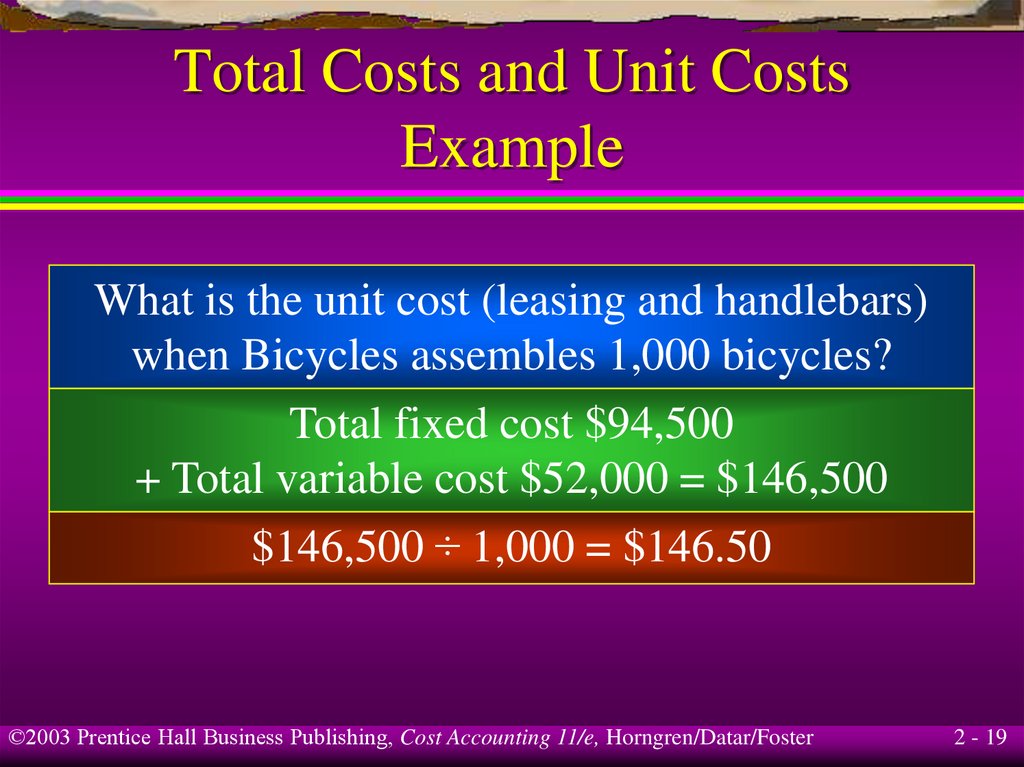




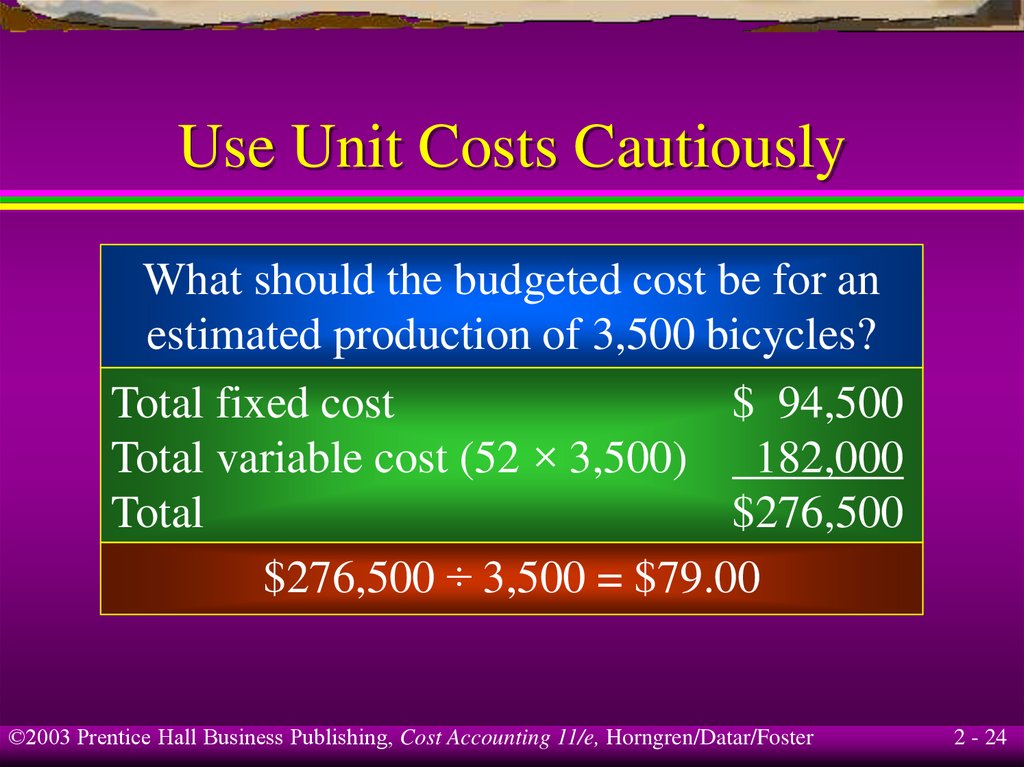
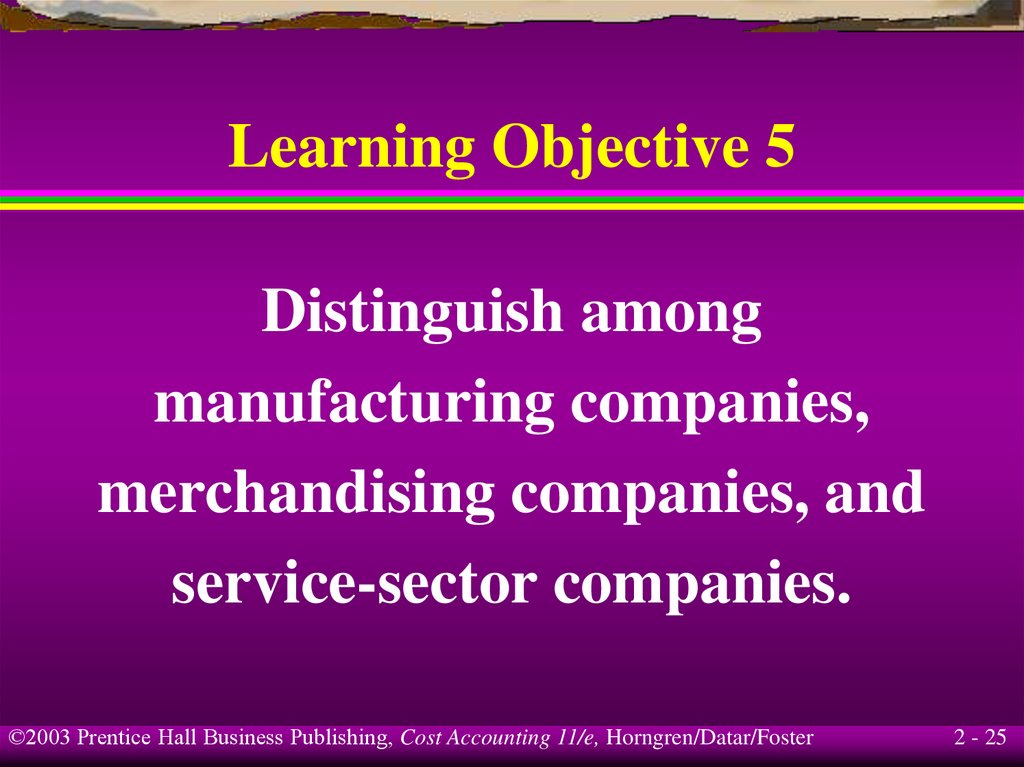

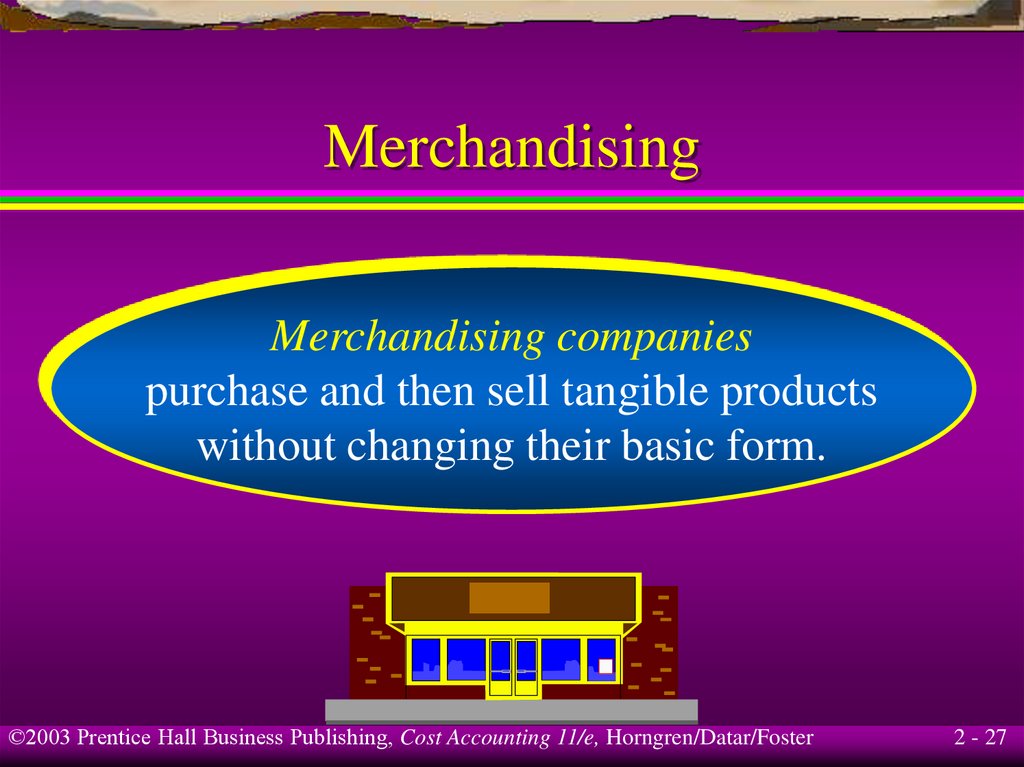
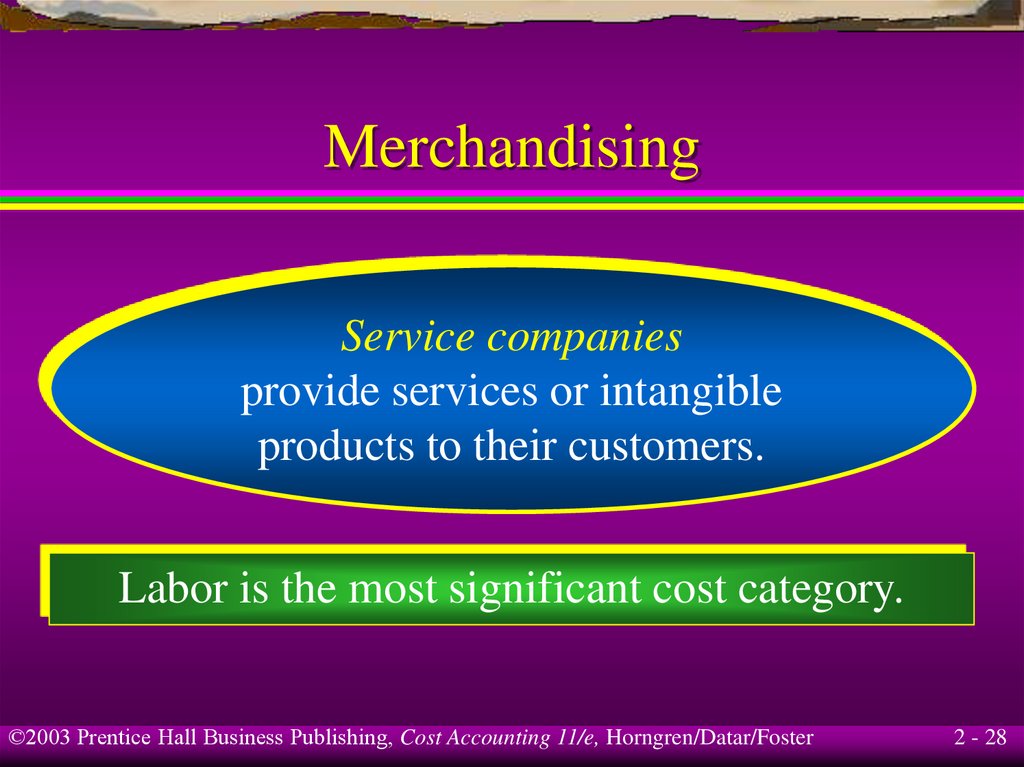


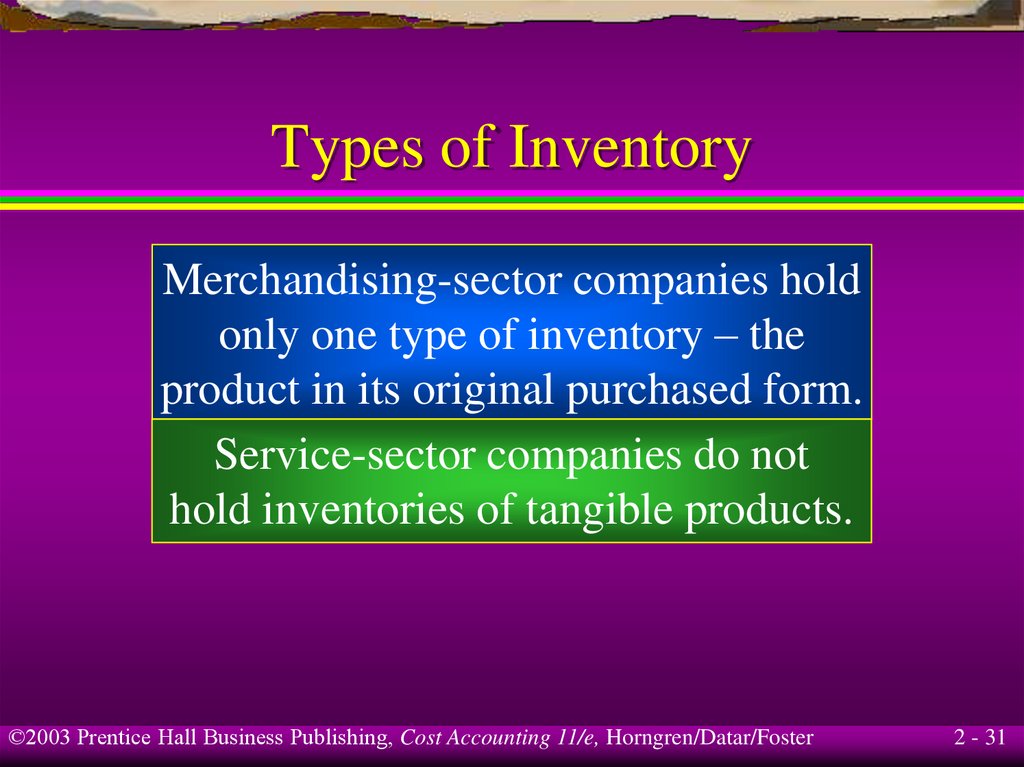
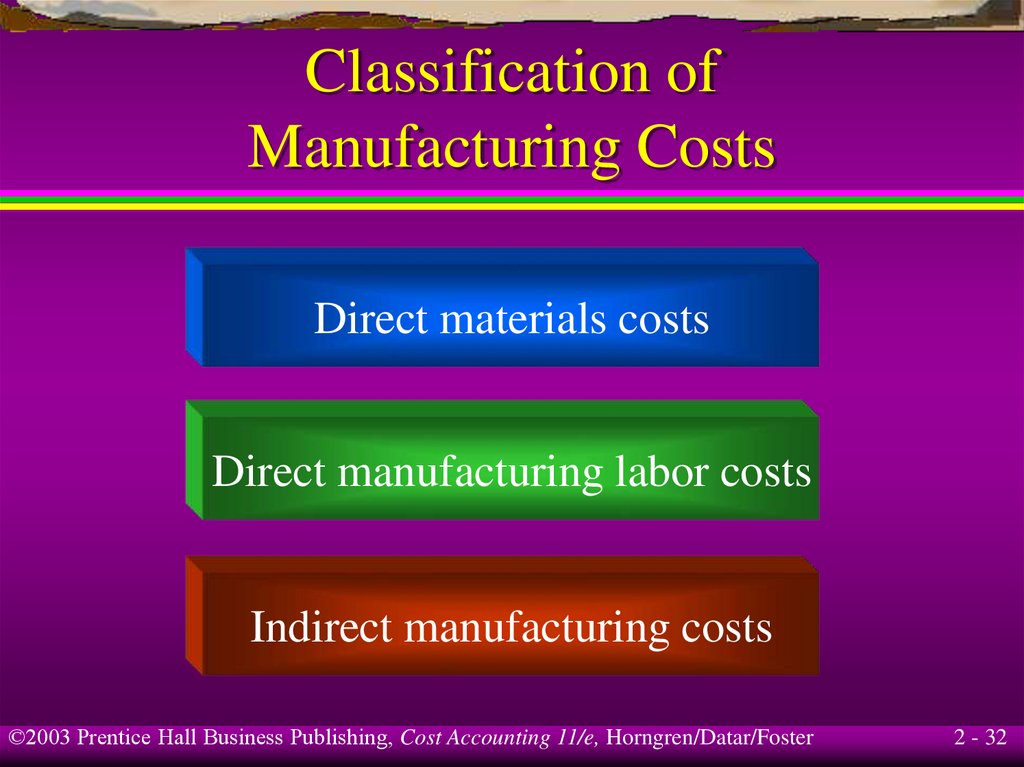
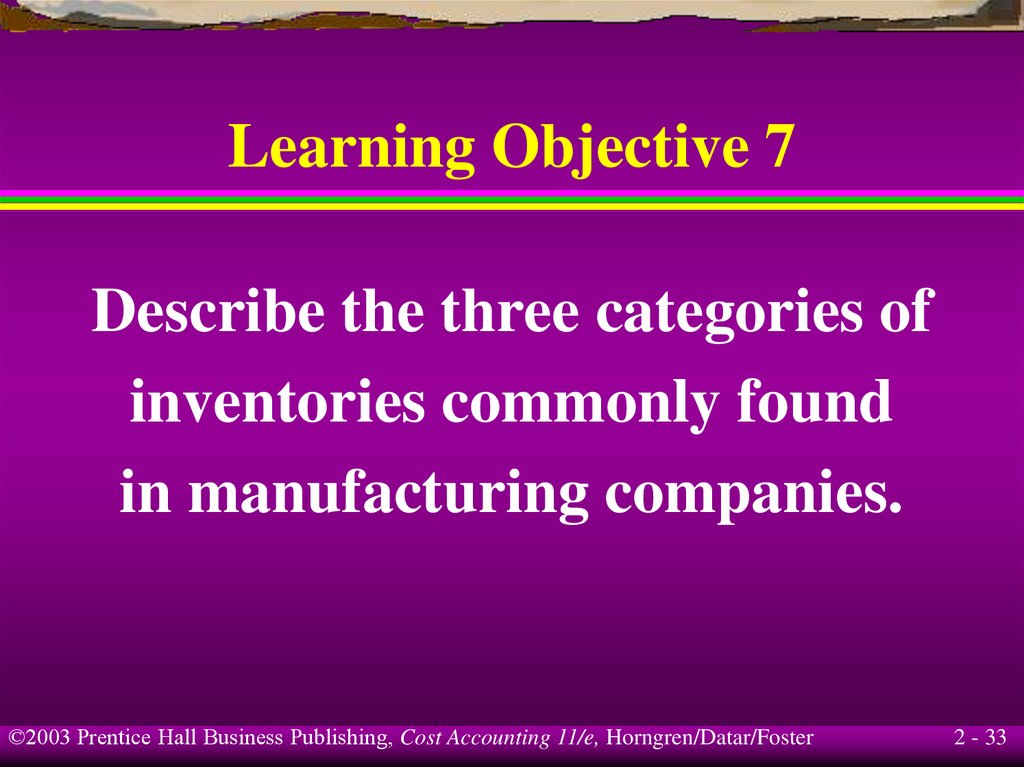
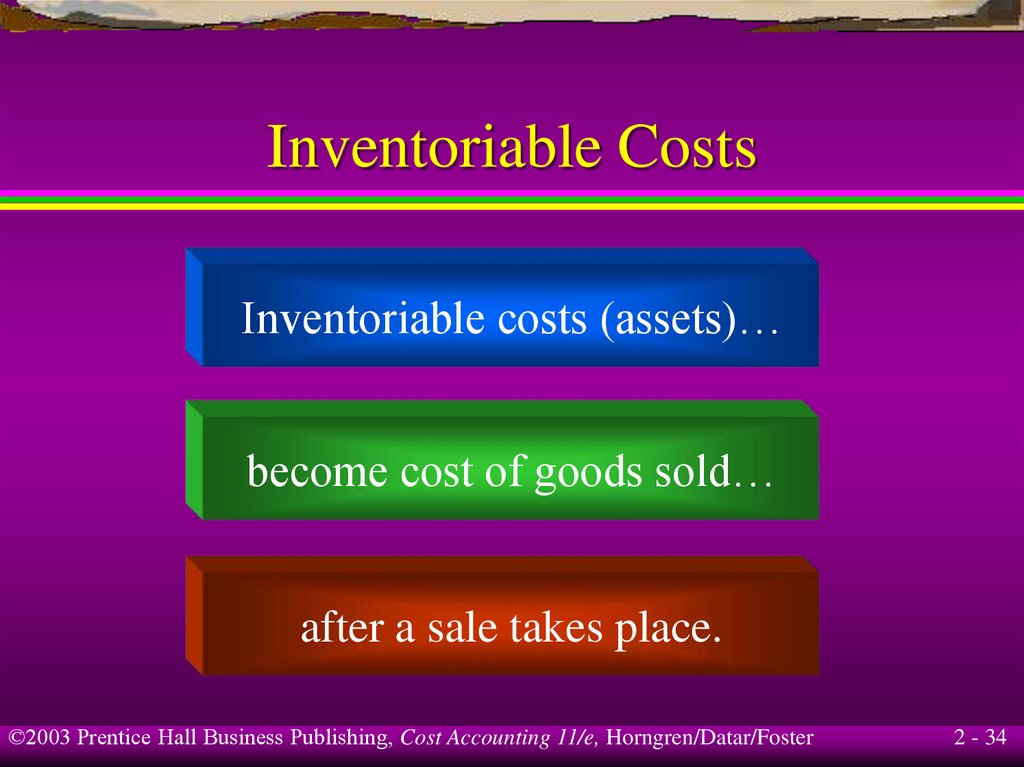

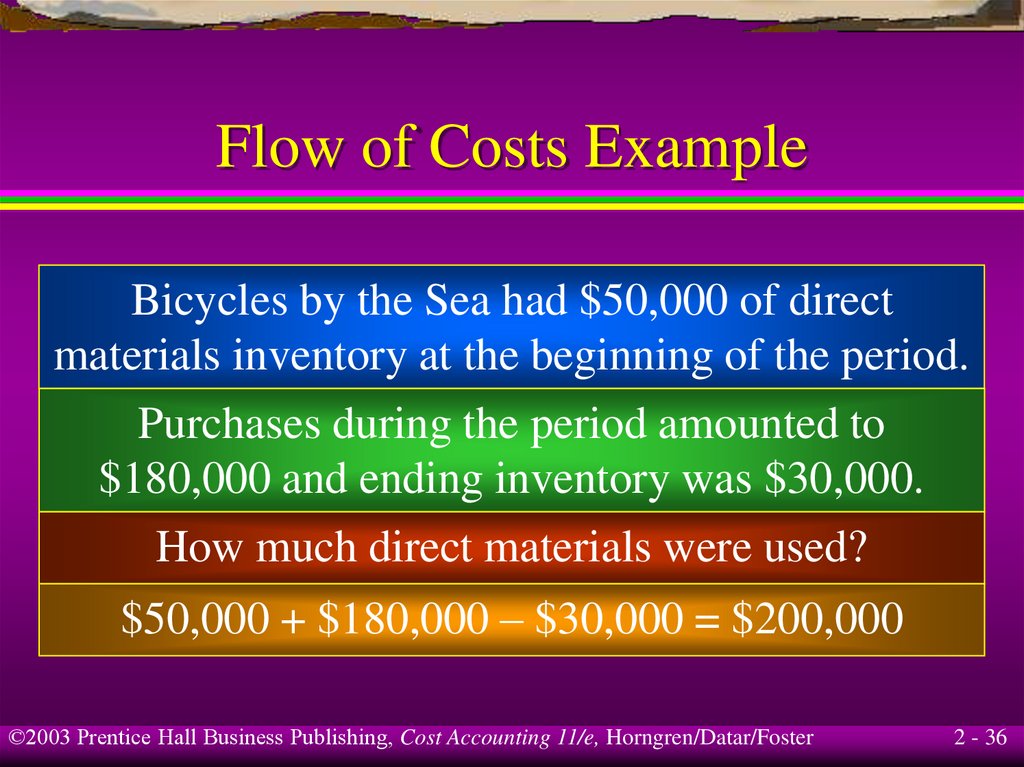
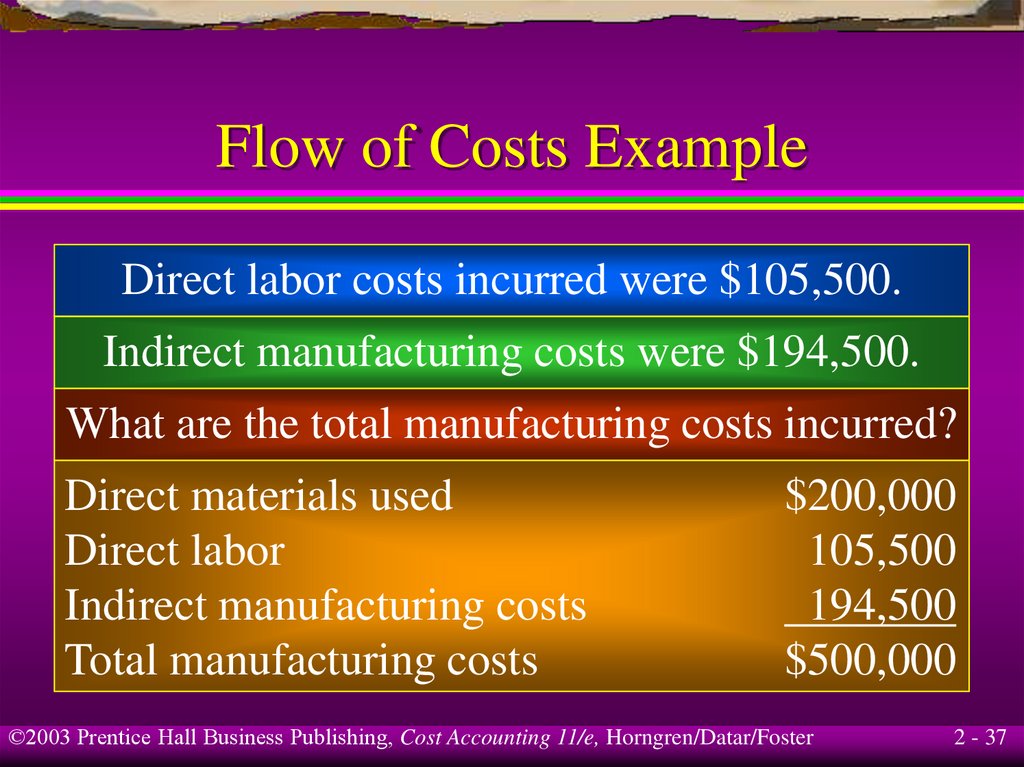
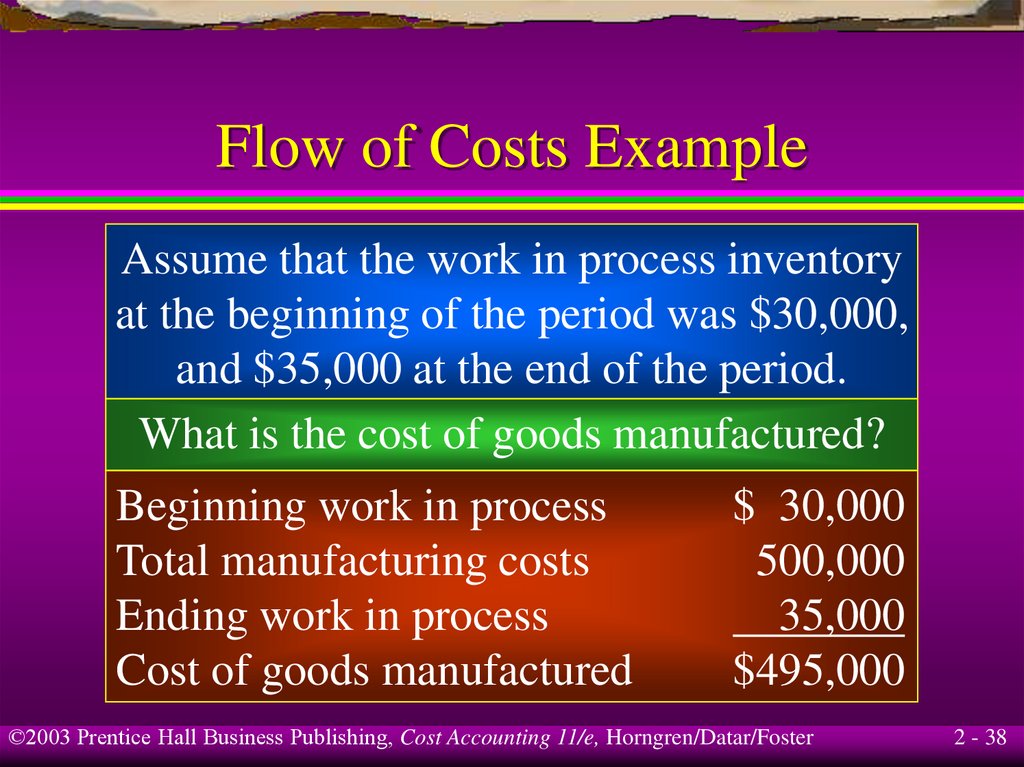
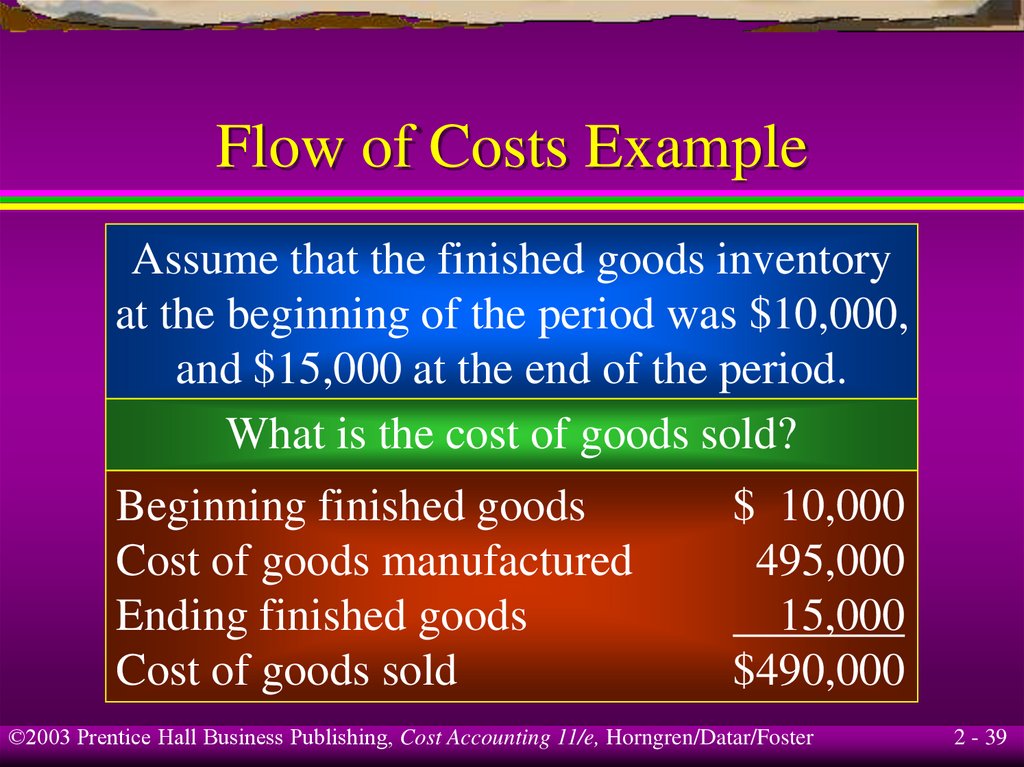
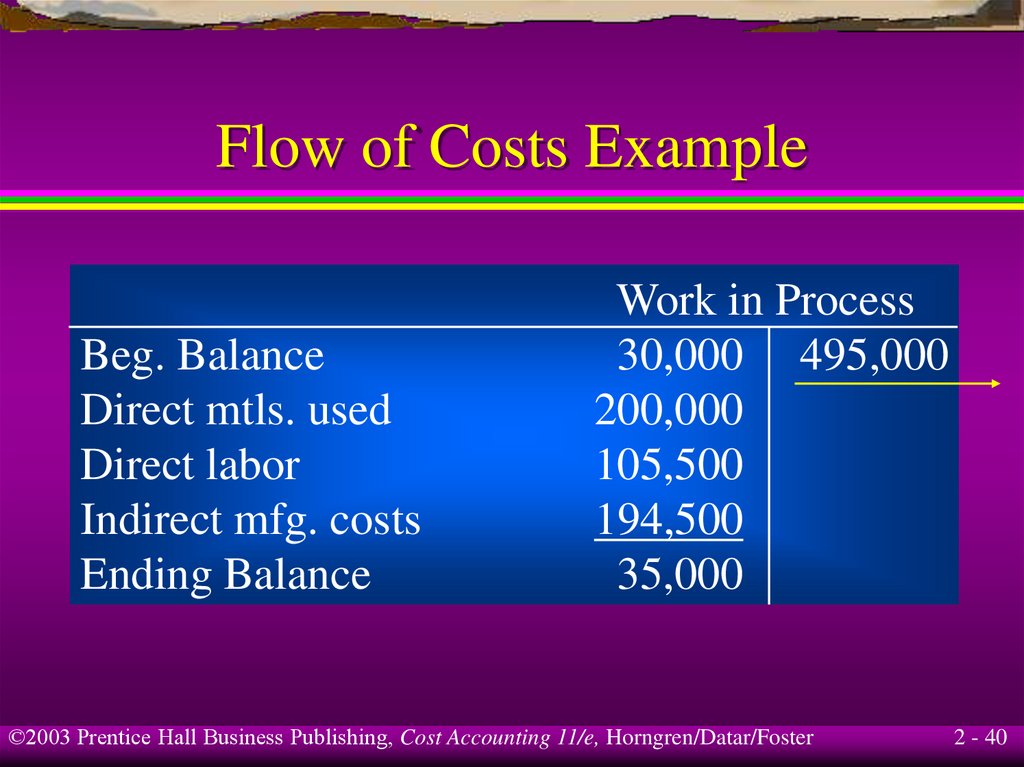
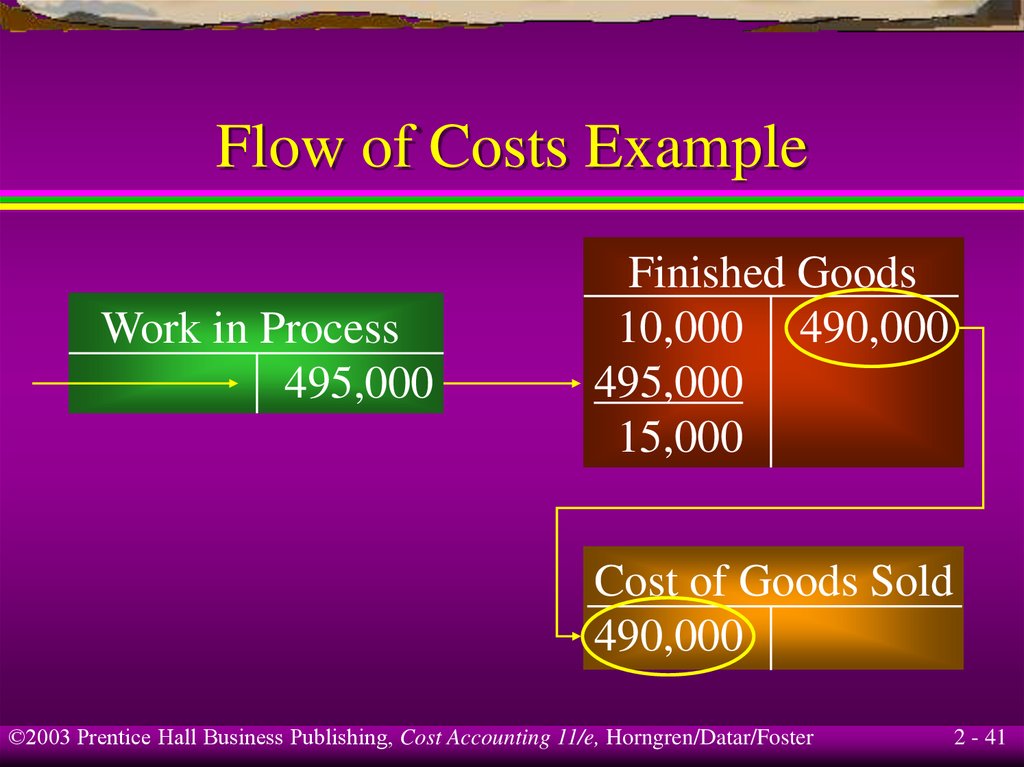
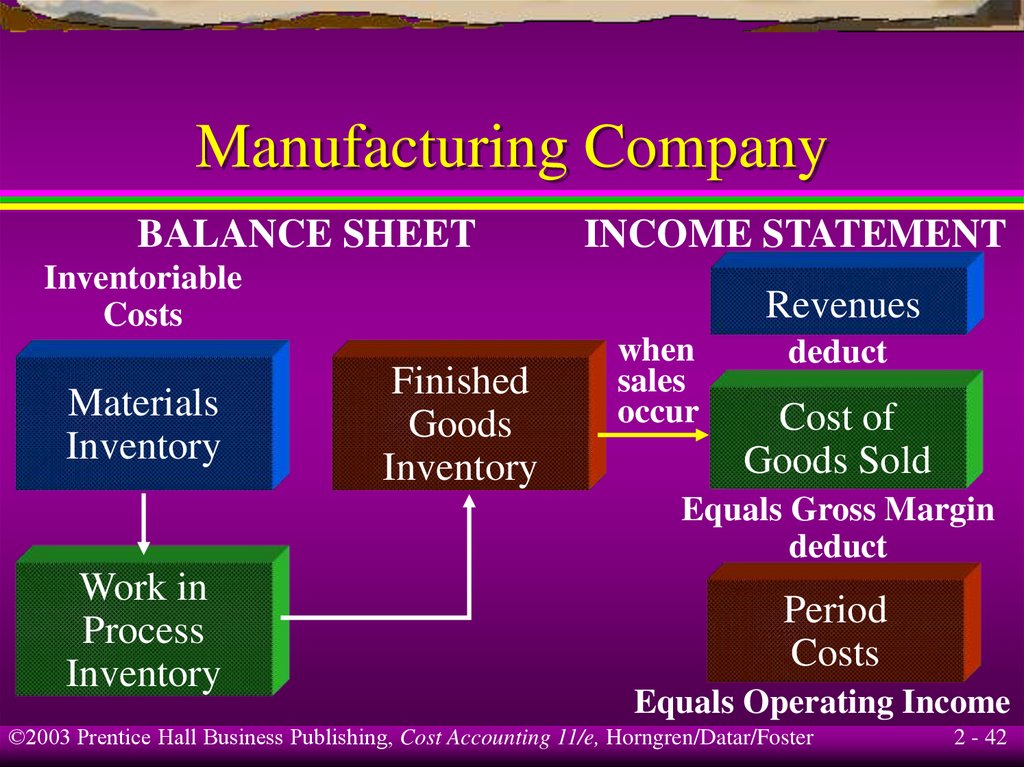
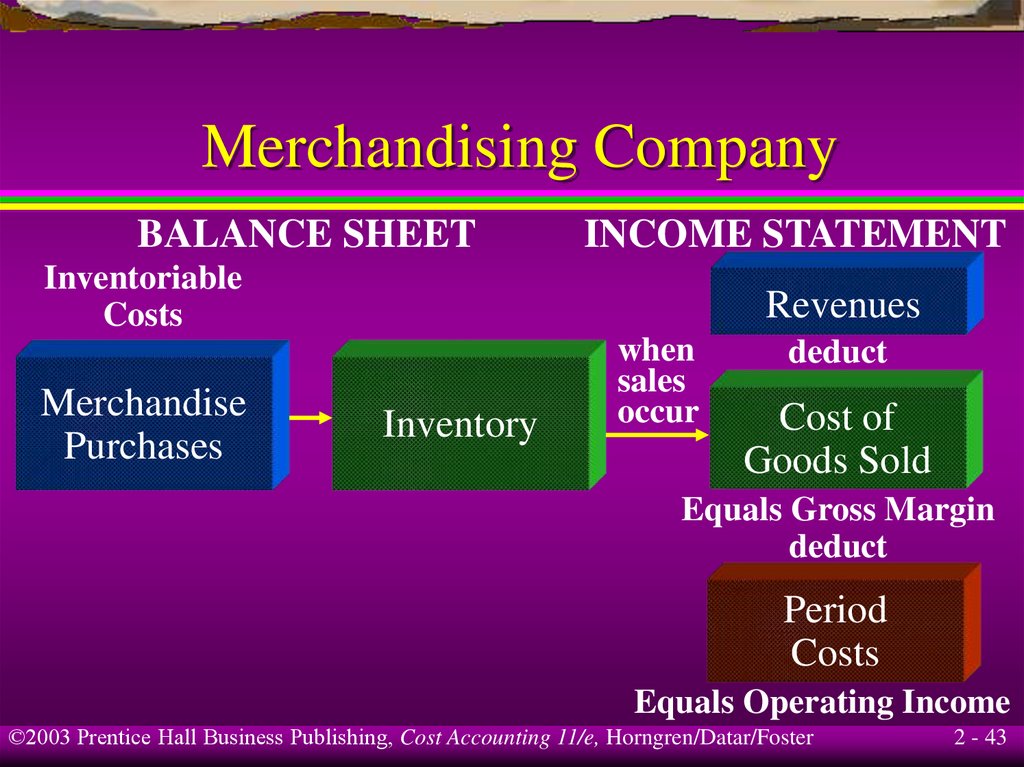
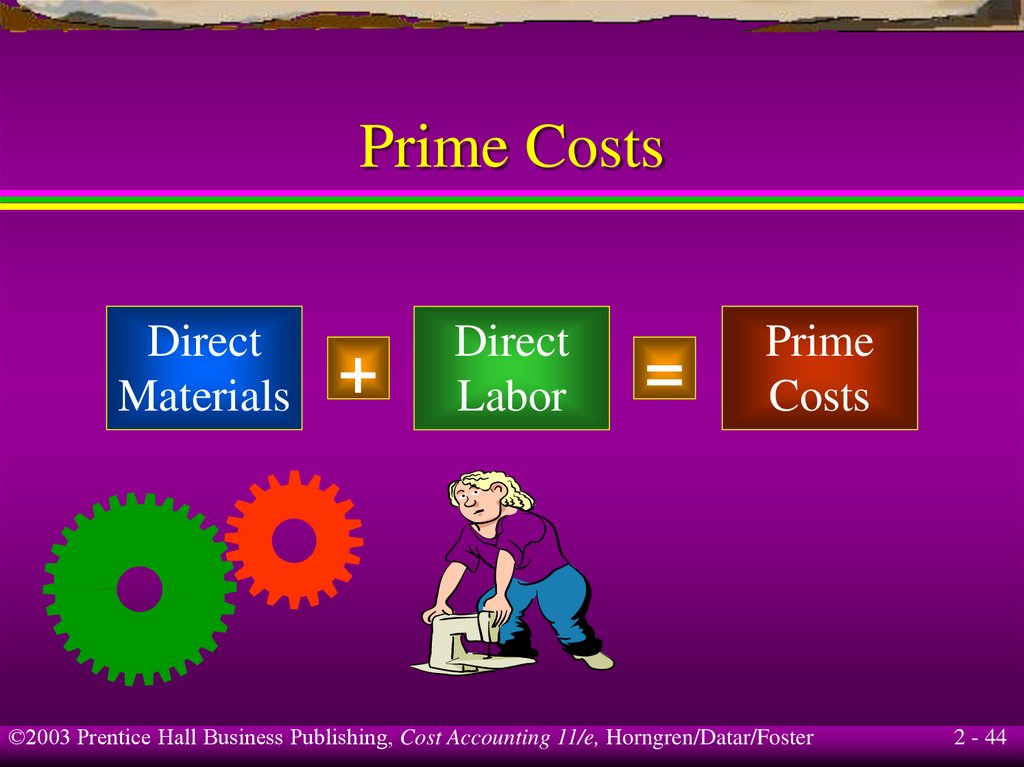
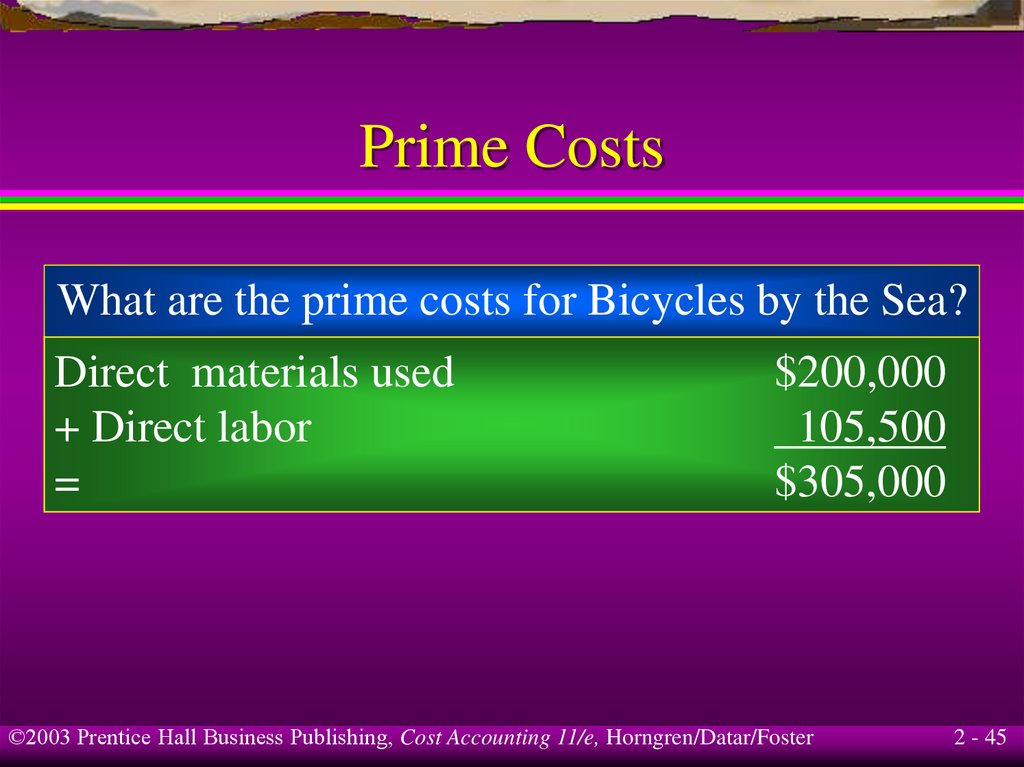
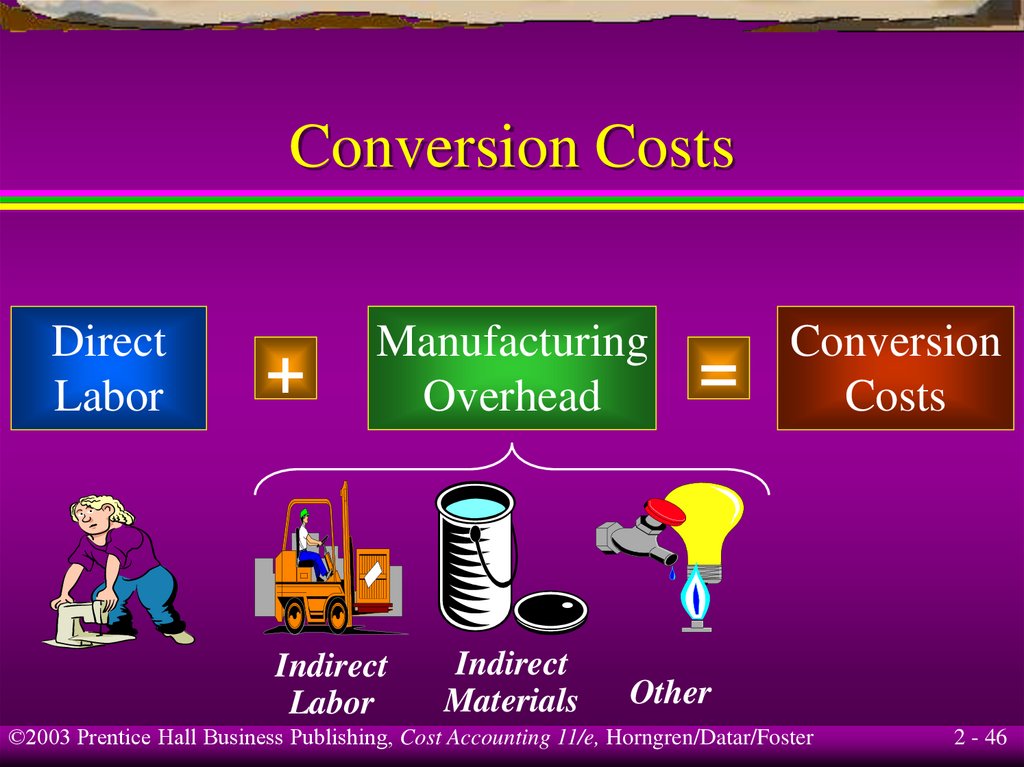
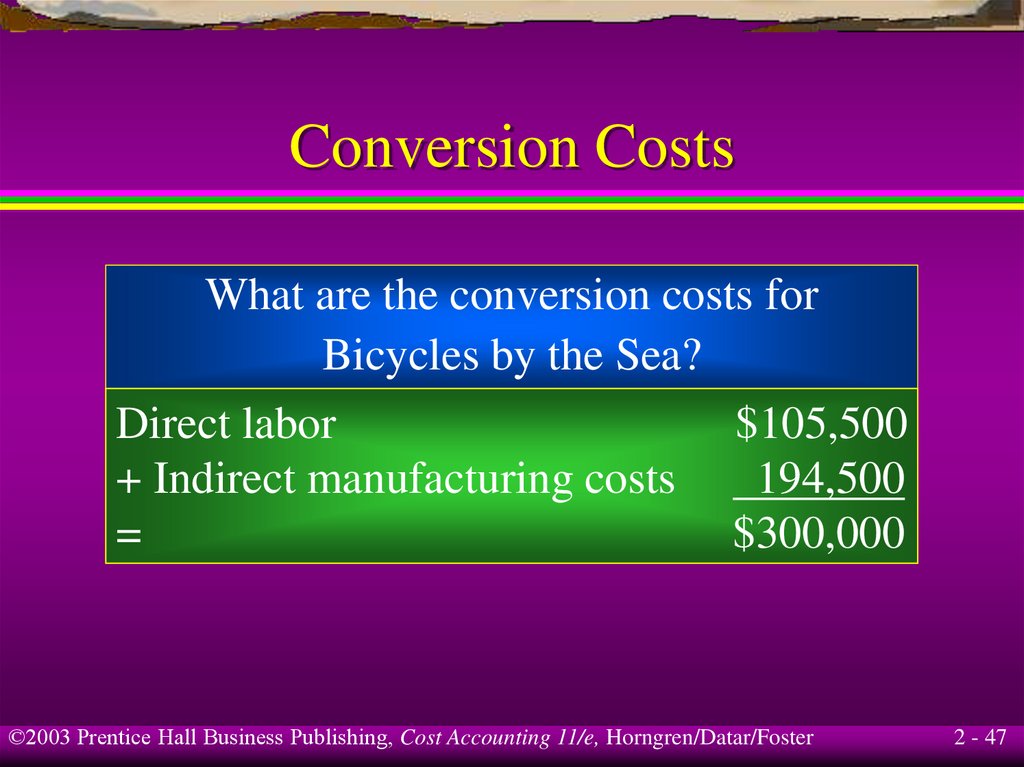
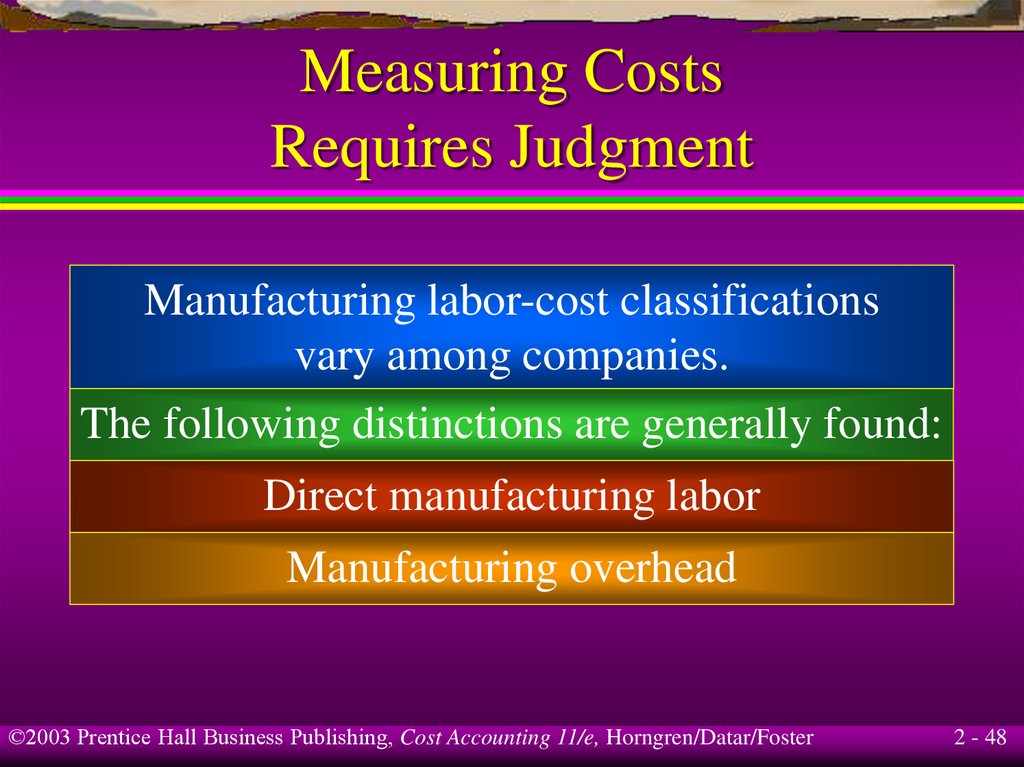
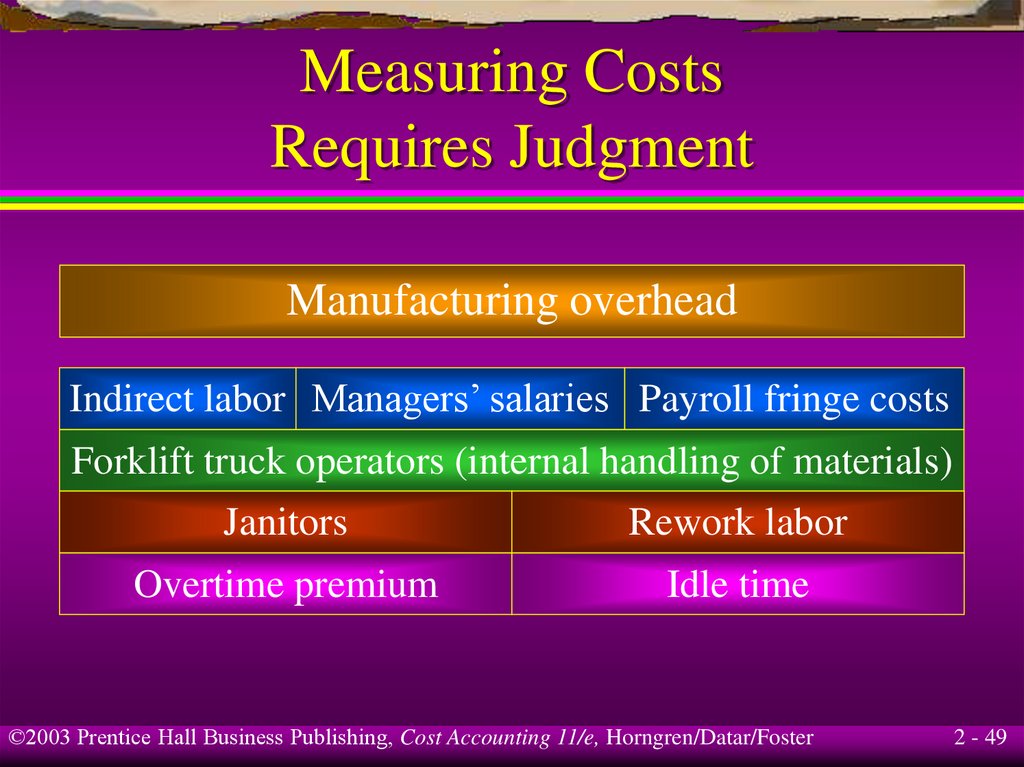

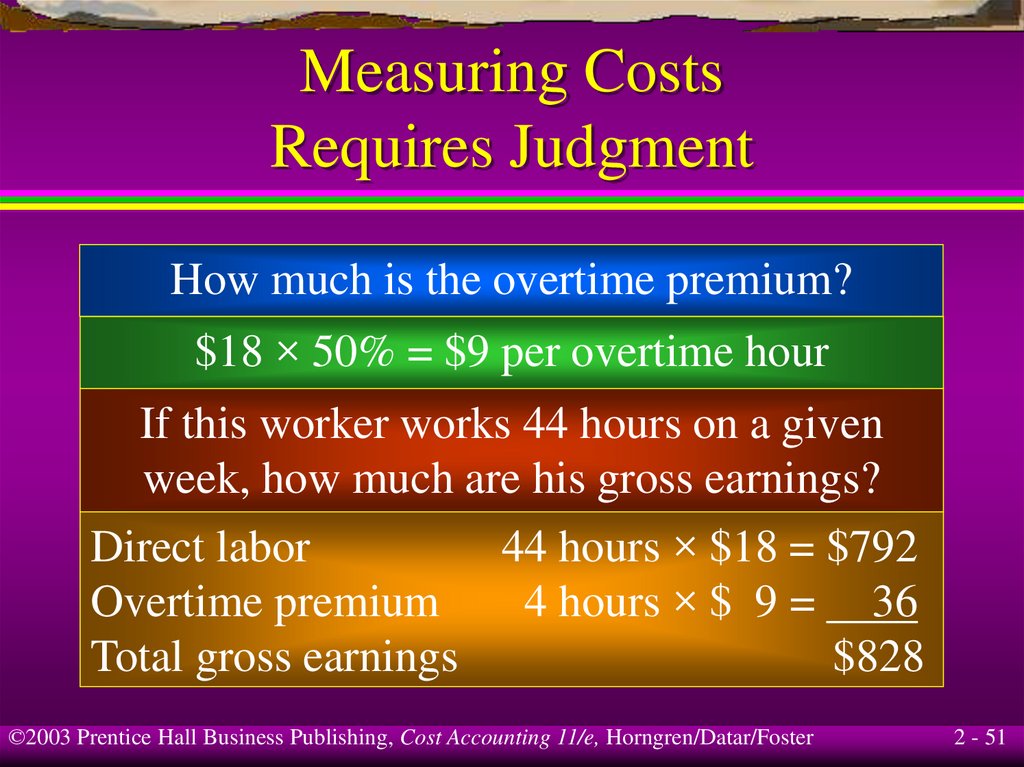
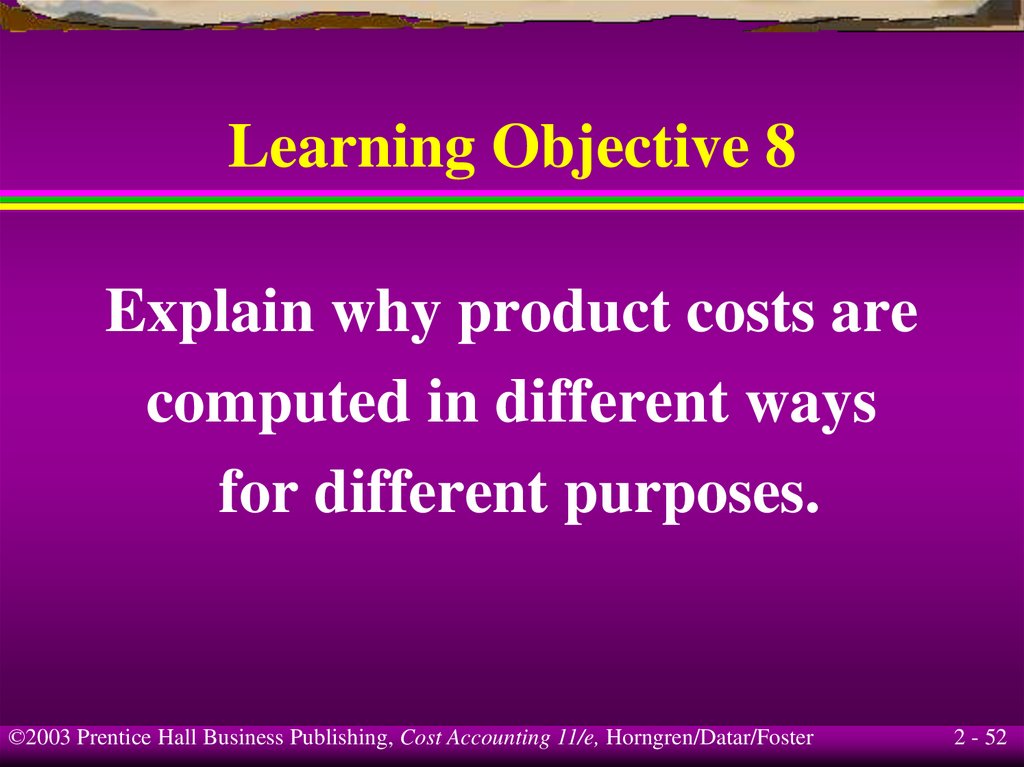
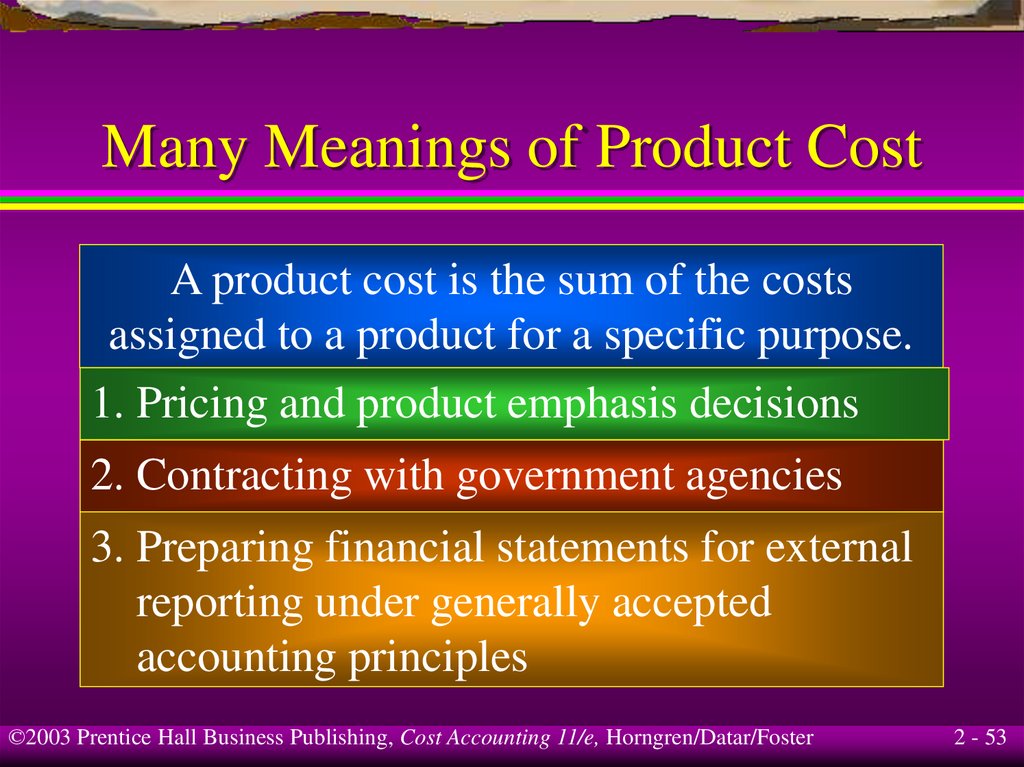
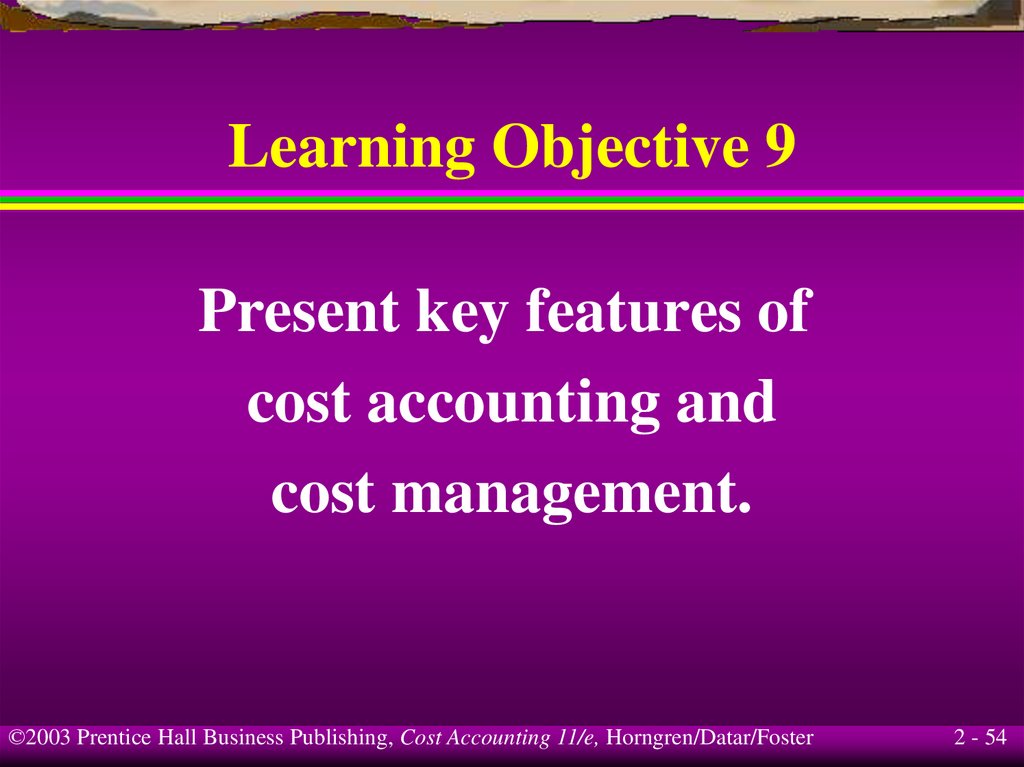
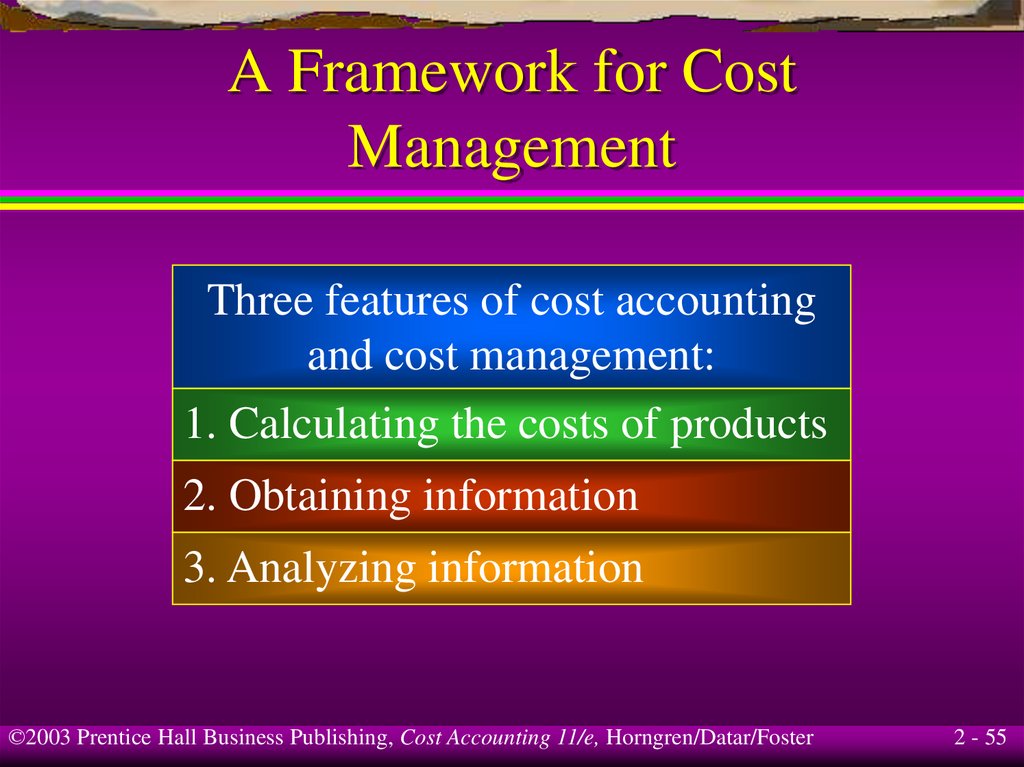
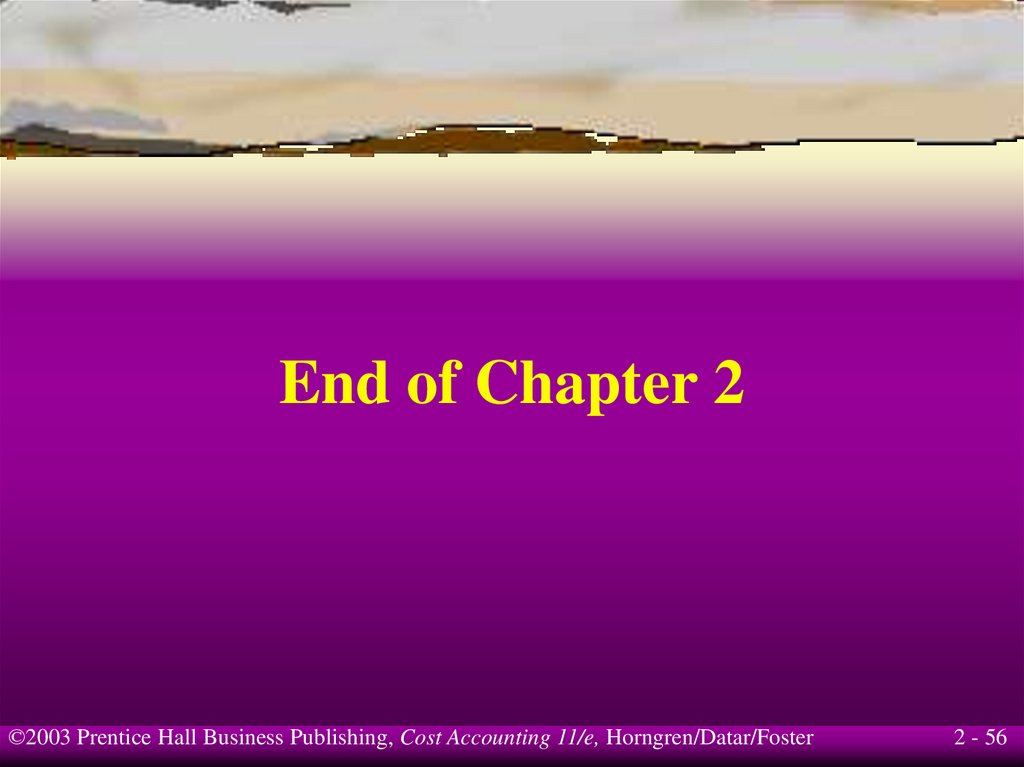
 finance
finance








